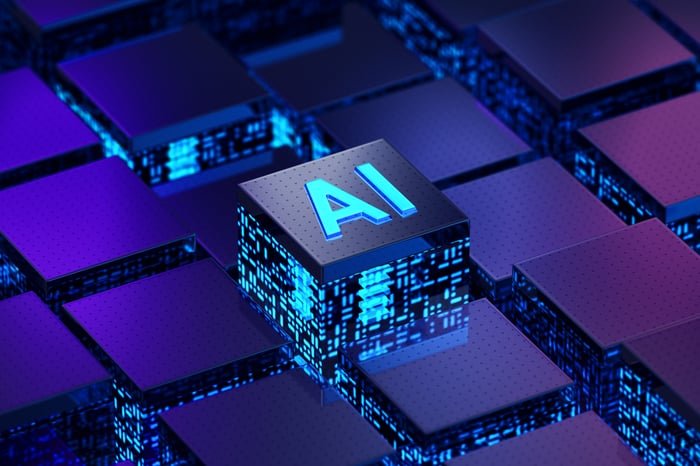AI Insights
5 Top Artificial Intelligence (AI) Stocks Ready for a Bull Run

While there is still uncertainty surrounding the implementation of tariffs by the Trump administration, at least one sector — artificial intelligence (AI) — is starting to regain its momentum and could be set up for another bull run. The technology is being hailed as a once-in-a-generation opportunity, and the early signs are that this could indeed be the case.
With AI still in its early innings, it’s not too late to invest in the sector. Let’s look at five AI stocks to consider buying right now.
Nvidia
Nvidia‘s (NVDA -0.22%) stock has already seen massive gains the past few years, but the bull case is far from over. The company’s graphics processing units (GPUs) are the main chips used for training large language models (LLMs), and it’s also seen strong traction in inference. These AI workloads both require a lot of processing power, which its GPUs provide.
The company captured an over 90% market share in the GPU space last quarter, in large thanks to its CUDA software platform, which makes it easy for developers to program its chips for various AI workloads. In the years following its launch, a collection of tools and libraries have also been built on top of CUDA that helps optimize Nvidia’s GPUs for AI tasks.
With the AI infrastructure buildout still appearing to be in its early stages, Nvidia continues to look well-positioned for the future. Meanwhile, it has also potential big markets emerging, such as the automobile space and autonomous driving.
AMD
While Nvidia dominates AI training, Advanced Micro Devices (AMD 3.87%) is carving out a space in AI inference. Inference is the process in which an AI model applies what it has learned during training to make real-time decisions. Over time, the inference market is expected to become much larger than the training market due to increased AI usage.
AMD’s ROCm software, meanwhile, is largely considered “good enough” for inference workloads, and cost-sensitive buyers are increasingly giving its MI300 chips a closer look. That’s already showing up in the numbers, with AMD’s data center revenue surging 57% last quarter to $3.7 billion.
Even modest market share gains from a smaller base could translate into meaningful top-line growth for AMD. Importantly, one of the largest AI model companies is now using AMD’s chips to handle a significant share of its inference traffic. Cloud giants are also using AMD’s GPUs for tasks like search and generative AI. Beyond GPUs, AMD remains a strong player in data center central processing units (CPUs), which is another area benefiting from rising AI infrastructure spend.
Taken altogether, AMD has a big AI opportunity in front of it.
Image source: Getty Images.
Alphabet
If you only listened to the naysayers, you would think Alphabet (GOOGL -0.91%) (GOOG -0.86%) is an AI loser, whose main search business is about to disappear. However, that would ignore the huge distribution and ad network advantages the company took decades to build.
Meanwhile, it has quietly positioned itself as an AI leader. Its Gemini model is widely considered one of the best and getting better. It’s now helping power its search business, and it’s added innovative elements that can help monetize AI, such as “Shop with AI,” which allows users to find products simply by describing them; and a new virtual try-on feature.
Google Cloud, meanwhile, has been a strong growth driver, and is now profitable after years of heavy investment. That segment grew revenue by 28% last quarter and continues to win share in the cloud computing market. The company also has developed its own custom AI chips, which OpenAI recently began testing as an alternative to Nvidia.
Alphabet also has exposure to autonomous driving through Waymo, which now operates a paid robotaxi service in multiple cities, and quantum computing with its Willow chip.
Alphabet is one of the world’s most innovative companies and has a long runway of continued growth still in front of it.
Pinterest (PINS -1.98%) has leaned heavily into AI to go from simply an online vision board to a more engaging platform that is shoppable. A key part of its transformation is its multimodal AI model that is trained on both images and text. This helps power its visual search feature, as well as generate more personalized recommendations. Meanwhile, on the backend, its Performance+ platform combines AI and automation to help advertisers run better campaigns.
The strategy is working, as the platform is both gaining more users and monetizing them better. Last quarter, it grew its monthly active users by 10% to 570 million. Much of that user growth is coming from emerging markets. Through the help of Google’s strong global ad network, with whom it’s partnered, Pinterest is also much better at monetizing these users. In the first quarter, its “rest of world” segment’s average revenue per user (ARPU) jumped 29%, while overall segment revenue soared 49%.
With a large but still undermonetized user base, Pinterest has a lot of growth ahead.
Salesforce
Salesforce (CRM -1.62%) is no stranger to innovation, being one of the first large companies to embrace the software-as-a-service (SaaS) model. A leader in customer relationship management (CRM) software, the company is now looking to become a leader in agentic AI and digital labor.
Salesforce’s CRM platform was built to give its users a unified view of their siloed data all in one place. This helped create efficiencies and reduce costs by giving real-time insights and allowing for improved forecasting.
With the advent of AI, it is now looking to use its platform to create a digital workforce of AI agents that can complete tasks with little human supervision. It believes that the combination of apps, data, automation, and metadata into a single framework it calls ADAM will give it a leg up in this new agentic AI race.
The company has a huge installed user base, and its new Agentforce platform is off to a good start with over 4,000 paying customers since its October launch. With its consumption-based product, the company has a huge opportunity ahead with AI agents.
AI Insights
Pittsburgh’s AI summit: five key takeaways

The push for artificial intelligence-related investments in Western Pennsylvania continued Thursday with a second conference that brought together business leaders and elected officials.
Not in attendance this time was President Donald Trump, who headlined a July 15 celebration of AI opportunity at Carnegie Mellon University.
This time Gov. Josh Shapiro, U.S. Sen. David McCormick and others converged in Bakery Square in Larimer to emphasize emerging public-private initiatives in anticipation of growing data center development and other artificial intelligence-related infrastructure including power plants.
Here’s what speakers and attendees at the summit were saying.
AI is not a fad
As regional leaders and business investors consider their options, BNY Mellon’s CEO Robin Vince cautioned against not taking AI seriously.
“The way to get left behind in the next 10 years is to not care about AI,” Vince said
“AI is transforming everything,” said Selin Song during Thursday’s event. As president of Google Customer Solutions, Song said that the company’s recent investment of $25 million across the Pennsylvania-Jersey-Maryland grid will help give AI training access to the more than 1 million small businesses in the state.
Google isn’t the only game in town
Shapiro noted that Amazon recently announced plans to spend at least $20 billion to establish multiple high-tech cloud computing and AI innovation campuses across the state.
“This is a generational change,” Shapiro said, calling it the largest private sector investment in Pennsylvania’s history. “This is our next chapter in innovative growth. It all fits together. This new investment is beyond data center 1.0 that we saw in Virginia.”
Fracking concerns elevated
With all of the plans for new power-hungry data centers, some are concerned that the AI push will create more environmental destruction. Outside the summit, Food & Water Watch Pennsylvania cautioned that the interest in AI development is a “Trojan horse” for more natural gas fracking. Amid President Donald Trump’s attempts to dismantle wind and solar power, alternatives to natural gas appear limited.
Nuclear ready for its moment
But one possible alternative was raised at the AI conference by Westinghouse Electric Company’s interim CEO Dan Summer.
The Pittsburgh-headquartered organization is leading a renewed interest in nuclear energy with plans to build a number of its AP 1000 reactors to help match energy needs and capabilities.
Summer said that the company is partnering with Google, allowing them to leverage Google’s AI capabilities “with our nuclear operations to construct new nuclear here.”
China vs. ‘heroes’
Underlying much of the AI activity: concerns with China’s work in this field
“With its vast resources, enormous capital, energy, workforce, the Chinese government is leveraging its resources to beat the United States in AI development,” said Nazak Nikakhtar, a national security and international trade attorney who chaired one of the panels Thursday.

Speaking to EQT’s CEO Toby Rice and Groq executive Ian Andrews, Nikakhtar outlined some of the challenges she saw in U.S. development of AI technology compared to China.
“We are attempting to leverage, now, our own resources, albeit in some respects much more limited vis-a-vis what China has, to accelerate AI leadership here in the United States and beat China,” she said. “But we’re somewhat constrained by the resources we have, by our population, by workforce, capital.”
Rice said in response that the natural resources his company is extracting will help power the country’s ability to compete with China.
Rice drew a link between the 9/11 terror attacks 24 years earlier and the “urgency” of competing with China in AI.
“People are looking to take down American economies,” Rice said. “And we have heroes. Never forget. And I do believe that us winning this race against China in AI is going to be one of the most heroic things we’re going to do.”
Eric Jankiewicz is PublicSource’s economic development reporter and can be reached at ericj@publicsource.org or on Twitter @ericjankiewicz.
AI Insights
Commanders vs. Packers props, SportsLine Machine Learning Model AI picks, bets: Jordan Love Over 223.5 yards

The NFL Week 2 schedule gets underway with a Thursday Night Football matchup between NFC playoff teams from a year ago. The Washington Commanders battle the Green Bay Packers beginning at 8:15 p.m. ET from Lambeau Field. Second-year quarterback Jayden Daniels led the Commanders to a 21-6 opening-day win over the New York Giants, completing 19 of 30 passes for 233 yards and one touchdown. Jordan Love, meanwhile, helped propel the Packers to a dominating 27-13 win over the Detroit Lions in Week 1. He completed 16 of 22 passes for 188 yards and two touchdowns.
NFL prop bettors will likely target the two young quarterbacks with NFL prop picks, in addition to proven playmakers like Deebo Samuel, Romeo Doubs and Zach Ertz. Green Bay’s Jayden Reed has been dealing with a foot injury, but still managed to haul in a touchdown pass in the opener, while Austin Ekeler (shoulder) does not carry an injury designation for TNF. The Packers enter as a 3-point favorite with Green Bay at -172 on the money line, while the over/under is 49 points. Before betting any Commanders vs. Packers props for Thursday Night Football, you need to see the Commanders vs. Packers prop predictions powered by SportsLine’s Machine Learning Model AI.
Built using cutting-edge artificial intelligence and machine learning techniques by SportsLine’s Data Science team, AI Predictions and AI Ratings are generated for each player prop.
For Packers vs. Commanders NFL betting on Monday Night Football, the Machine Learning Model has evaluated the NFL player prop odds and provided Commanders vs. Packers prop picks. You can only see the Machine Learning Model player prop predictions for Washington vs. Green Bay here.
Top NFL player prop bets for Commanders vs. Packers
After analyzing the Commanders vs. Packers props and examining the dozens of NFL player prop markets, the SportsLine’s Machine Learning Model says Packers quarterback Love goes Over 223.5 passing yards (-112 at FanDuel). Love passed for 224 or more yards in eight games a year ago, despite an injury-filled season. In 15 regular-season games in 2024, he completed 63.1% of his passes for 3,389 yards and 25 touchdowns with 11 interceptions. Additionally, Washington allowed an average of 240.3 passing yards per game on the road last season.
In a 30-13 win over the Seattle Seahawks on Dec. 15, he completed 20 of 27 passes for 229 yards and two touchdowns. Love completed 21 of 28 passes for 274 yards and two scores in a 30-17 victory over the Miami Dolphins on Nov. 28. The model projects Love to pass for 259.5 yards, giving this prop bet a 4.5 rating out of 5. See more NFL props here, and new users can also target the FanDuel promo code, which offers new users $300 in bonus bets if their first $5 bet wins:
How to make NFL player prop bets for Washington vs. Green Bay
In addition, the SportsLine Machine Learning Model says another star sails past his total and has nine additional NFL props that are rated four stars or better. You need to see the Machine Learning Model analysis before making any Commanders vs. Packers prop bets for Thursday Night Football.
Which Commanders vs. Packers prop bets should you target for Thursday Night Football? Visit SportsLine now to see the top Commanders vs. Packers props, all from the SportsLine Machine Learning Model.
AI Insights
Adobe Says Its AI Sales Are Coming in Strong. But Will It Lift the Stock?

Adobe (ADBE) just reported record quarterly revenue driven by artificial intelligence gains. Will it revive confidence in the stock?
The creative software giant late Thursday posted adjusted earnings per share of $5.31 on revenue that jumped 11% year-over-year to a record $5.99 billion in the fiscal third quarter, above analysts’ estimates compiled by Visible Alpha, as AI revenues topped company targets.
CEO Shantanu Narayen said that with the third-quarter’s revenue driven by AI, Adobe has already surpassed its “AI-first” revenue goals for the year, leading the company to boost its outlook. The company said it now anticipates full-year adjusted earnings of $20.80 to $20.85 per share and revenue of $23.65 billion to $23.7 billion, up from adjusted earnings of $20.50 to $20.70 on revenue of $23.50 billion to $23.6 billion previously.
Shares of Adobe were recently rising in late trading. But they’ve had a tough year so far, with the stock down more than 20% for 2025 through Thursday’s close amid worries about the company’s AI progress and growing competition.
Wall Street is optimistic. The shares finished Thursday a bit below $351, and the mean price target as tracked by Visible Alpha, above $461, represents a more than 30% premium. Most of the analysts tracking the stock have “buy” ratings.
But even that target represents a degree of caution in the context of recent highs. The shares were above $600 in February 2024.
-

 Business2 weeks ago
Business2 weeks agoThe Guardian view on Trump and the Fed: independence is no substitute for accountability | Editorial
-
Tools & Platforms1 month ago
Building Trust in Military AI Starts with Opening the Black Box – War on the Rocks
-

 Ethics & Policy2 months ago
Ethics & Policy2 months agoSDAIA Supports Saudi Arabia’s Leadership in Shaping Global AI Ethics, Policy, and Research – وكالة الأنباء السعودية
-

 Events & Conferences4 months ago
Events & Conferences4 months agoJourney to 1000 models: Scaling Instagram’s recommendation system
-

 Jobs & Careers2 months ago
Jobs & Careers2 months agoMumbai-based Perplexity Alternative Has 60k+ Users Without Funding
-

 Podcasts & Talks2 months ago
Podcasts & Talks2 months agoHappy 4th of July! 🎆 Made with Veo 3 in Gemini
-

 Education2 months ago
Education2 months agoVEX Robotics launches AI-powered classroom robotics system
-

 Education2 months ago
Education2 months agoMacron says UK and France have duty to tackle illegal migration ‘with humanity, solidarity and firmness’ – UK politics live | Politics
-

 Funding & Business2 months ago
Funding & Business2 months agoKayak and Expedia race to build AI travel agents that turn social posts into itineraries
-

 Podcasts & Talks2 months ago
Podcasts & Talks2 months agoOpenAI 🤝 @teamganassi

